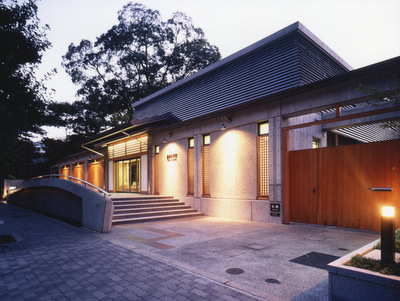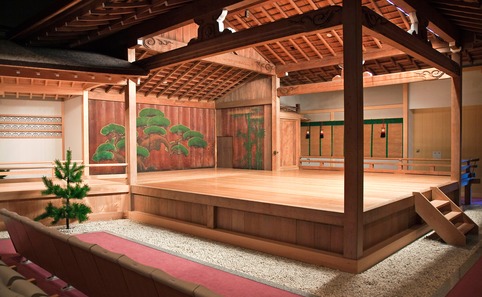On Sunday 24th of November a special celebratory event marked the 10th anniversary of the construction of the new Kongō Nō theatre, in Kyoto. The old theatre in Muromachi-street was a landmark in the history of Kyoto Noh, as it was the only stage rebuilt after all three main stages in Kyoto were burnt during the the Meiji upheavals. In 2004 the new state-of-the-art Kongō theatre opened on Karasuma street, in front of the imperial palace. I never had the pleasure of visiting the old theatre, but I heard many stories about it from actors in the school. It still had tatami mats instead of chairs, and large windows that let warm daylight illuminate the stage, across clouds of tobacco smoke lifting from the back seats. There, important guests would be able to sit in privacy, hidden behind lowered bamboo curtains, which they would lift only to watch the performance. Unfortunately the building did not conform to the modern health & safety (and fire protection) standards, and had to be demolished.
The Shin-Kongō Nōgakudō (New Kongō Nōgakudō) is one of the best Noh theatres I have ever visited. The design style of the building mixes traditional and modern, wood and concrete, in a unique blend that creates an atmosphere that is not too relaxed, nor too intimidating. It has comfortable armchairs (but not too dangerously comfortable), and the temperature usually is just right, unlike other places where you either freeze or steam.
Sunday’s performance opened with a special variation of Okina a ritual performance celebrating long and prosperous life. In this variation, called jūnitsukiōrai, the Iemoto Kongō Hisanori and his son Kongō Tatsunori took the roles of two Okina exchanging verses describing the characteristics of each lunar month. The choice of the variation was excellent because it emphasises the cycle of time and seasons with both the Kongō father and son on stage, symbolising the generational transmission of the Kongō heritage. It closed with a final left-right salutation from Kongō Tatsunori, who will be the future Iemoto.
The maibayashi extracted from the Noh Ema featured three of the senior Noh actors in the Kongō school, Teshima Michiharu, Imai Kiyotaka and my teacher, Udaka Michishige, who took the strong role of the god Tajikarao, pulling the Sun-Goddess Amaterasu out of the cave where she was hiding.
Hagoromo (shōgi no monogi variation) featured the beautiful ‘phoenix robe’, a costume only worn by the Kongō Iemoto. In this variation the tennyō (celestial maid) dons the costume while sitting on a stool in the middle of the stage.
Shakkyō (The Stone Bridge) concluded the long day of performances, with Kongō Tatsunori taking the role of the lion (an avatar of the Bodhisattva Manjusri) frolicking among white and red peonies.


